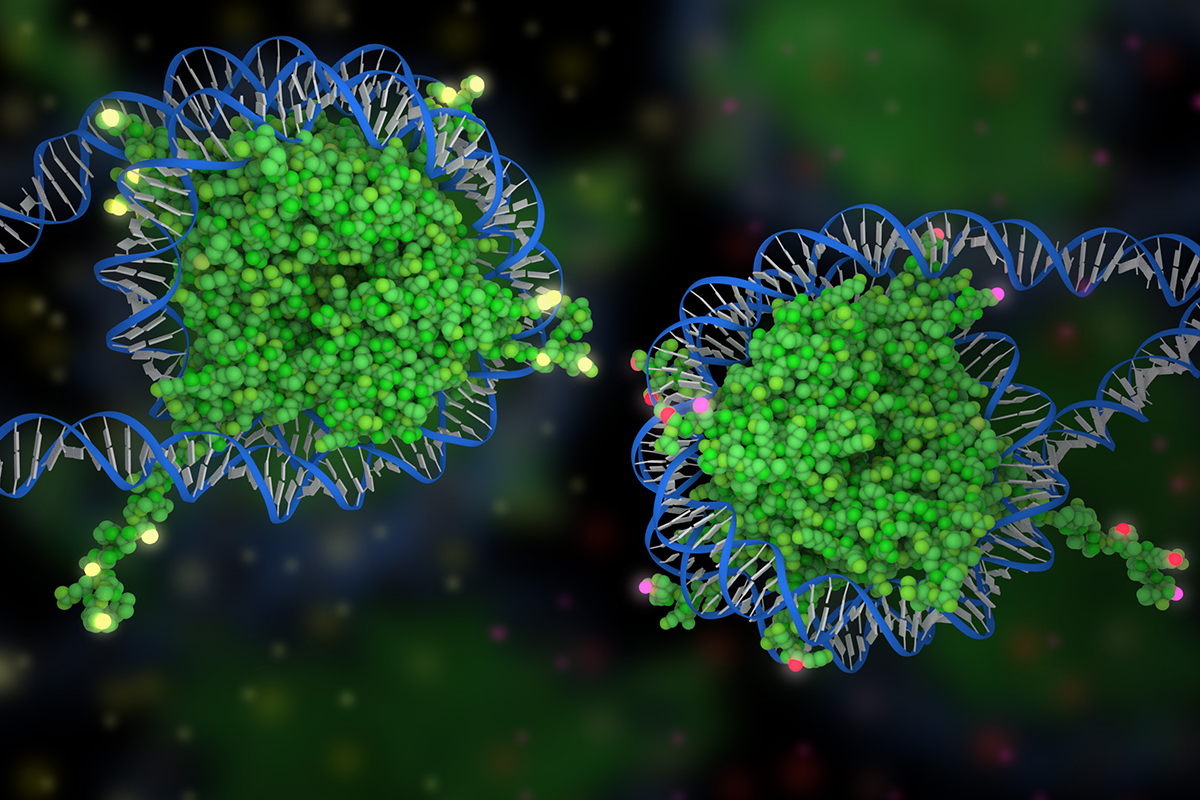
If you’ve ever known a set of identical twins, you might have been struck by what they didn’t have in common. Maybe one was a skilled musician, while the other couldn’t carry a tune. Maybe one craved adventure, while the other preferred the couch. These anecdotal examples reveal a fundamental truth about genetics: Even two people who share the exact same DNA can differ substantially in their attributes.
The same is true of cells. Every cell in your body — from the retinal cells in your eyes to the skin cells in your toes — contains the same set of about 20,000 genes. Yet somehow, this common genetic blueprint provides the basis for each cell’s individuality.
Welcome to epigenetics, the study of how these curious differences come about.
Epigenetics has captured the public’s attention in recent years in a way that few other technical scientific topics have. It’s not uncommon to read headlines about the “epigenetic revolution” and hear claims that epigenetics overthrows our understanding of evolution. So what exactly is epigenetics? How does it work? And why does it matter?
Phenomenological Puzzles
The word “epigenetic” literally means “above the genes.” Its real-world meaning can depend on who you ask, but one common definition is changes in gene activity that do not involve changes in DNA sequence.
Researchers started to become interested in epigenetics about two decades ago, as a way to make sense of certain biological phenomena that were otherwise hard to explain. “You had all these cases where things were clearly identical, genetically, but behaving differently,” says Mary Goll, a developmental biologist who studies epigenetics in zebrafish. “This suggested that there had to be something chromosomal and not related to the DNA sequence that was mediating that behavior.”
In a cell, DNA does not exist as a naked molecule. It is spooled around proteins called histones and decorated with other chemicals. This chromosomal packaging, collectively termed chromatin, can affect whether genes are turned on or off. For example, genes that are tagged with chemicals called methyl groups, or ones located near a more tightly wound section of chromosome, might be turned off, whereas genes located near more open regions might be turned on. Even whole chromosomes can be shut down, zipped up like a compressed file in your email inbox. (An example of this is X-inactivation, when one of the two X chromosomes in the cell of a female animal is inactivated.)
One way to appreciate the importance of these epigenetic mechanisms is to ask what happens when they malfunction. “It’s definitely clear that changes to the epigenome — meaning DNA methylation, histone modifications, and the chromatin state — influence what genes are expressed,” says Omar Abdel-Wahab, a physician-scientist in the Human Oncology and Pathogenesis Program at MSK who studies the role of epigenetics in blood cancers. “We learned that in part through cancer.”
Mutations in the proteins that carry out these epigenetic modifications, he says, can completely change the characteristics of a cell and promote cancer. And in fact, drugs targeting these epigenetic changes are now a promising form of cancer treatment, including several that are in development at MSK’s Center for Epigenetics Research. One such drug, enasidenib (Idhifa®), was approved in 2017.

Driver or Executioner
Biologists have known for a long time that gene expression is different in different cell types. What makes one cell look and act different from another is the particular set of genes that are turned on in that cell and the particular proteins that are made as a result. (B cells of the immune system make antibodies, for example, while muscle cells make a motor protein called myosin.)
The textbook view of gene regulation is that proteins called transcription factors act as molecular switches, turning genes on or off by binding to DNA. The pattens of gene expression created by these switches are self-sustaining, helping to maintain a cell’s distinct identity. MSK’s own Mark Ptashne did much to establish these fundamental principles, for which he won the Lasker Award in 1997.

In this view, chromatin is seen as mostly structural packaging, without much of an active role. But researchers now know that chromatin has a more consequential role to play in gene expression. Modifications to the histones in chromatin, for example, can shape what regions of the genome are open or closed, and in turn affect which genes are turned on or off. The debate now centers on which of these cellular actors are “drivers” and which are “executioners” of gene regulation.
Ross Levine, a physician-scientist at MSK studying epigenetics in leukemia, thinks that epigenetic markings function as molecular bookmarks, allowing cells to find what they’re looking for amidst the 3 billion DNA base pairs in our genome. “Epigenetics is the cellular equivalent of how to locate and place bookmarks that allow different cells to access different aspects of this tome at different times,” he says.
Epigenetic therapies like the ones he and his colleagues are working on help cells to restore many of these bookmarks, allowing them to bring gene expression back under control and return to normal. Unlike genetic mutations, epigenetic changes can be reversible.
Controversial Conclusions
Epigenetics has generated buzz recently because it seems to offer a way for our life experiences to modify our genetic inheritance, and therefore alter our genetic “fate.” What we experience in the womb or early life may affect our risk of disease many years later, for instance.
Yet the idea that experience can alter gene expression is really nothing new. The outside world is continually impinging on us in ways that change how our genes are expressed. When we cut ourselves, for example, genes for making new skin cells are turned on. When we learn to play the violin, gene expression in our brain changes.
A far more controversial claim — made by some writers and scientists — is that epigenetic changes may be inherited across generations. To evolutionary biologists, this raises the specter of Lamarckism. This notion, espoused by the naturalist Jean-Baptiste Lamarck in the early 1800s, is that experience acquired in one generation can be passed on to the next and account for the evolution of new adaptations.
According to Dr. Goll, there are few clear examples of trans-generational epigenetic inheritance described in mammals. And there’s good reason to think it’s unlikely: “In mammals, there’s a really robust system for making sure that trans-generational inheritance doesn’t happen — a period during embryonic development when DNA methylation is rapidly erased and reestablished,” she says. “So that should theoretically clear out anything.”
There may be a few spots, she notes, where methylation marks are harder to erase than others, permitting some small amount of germline epigenetic inheritance. “But is eating an apple in the morning when you’re pregnant going to affect what traits your grandchildren inherit? Probably not,” she says.






